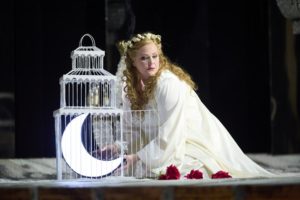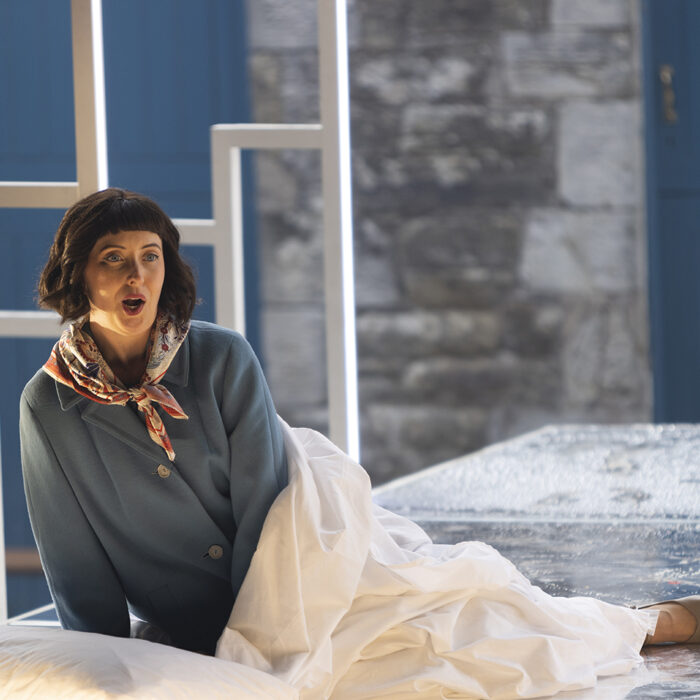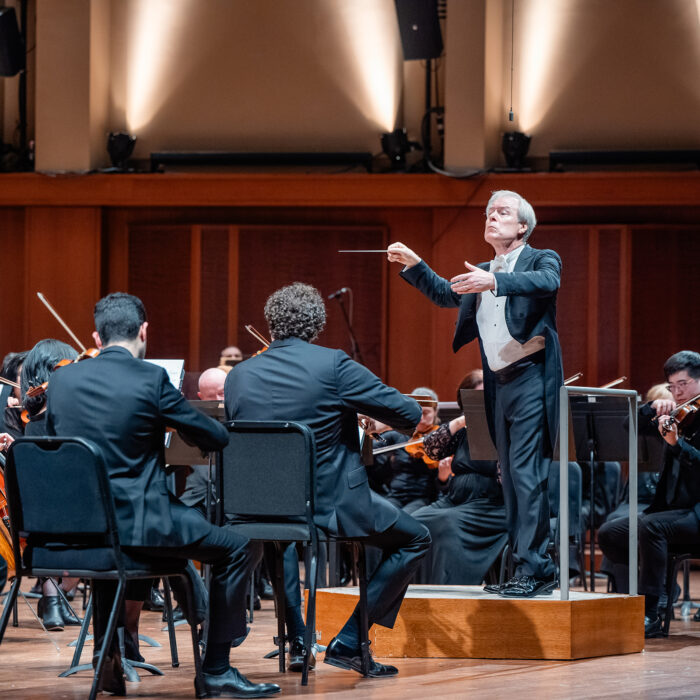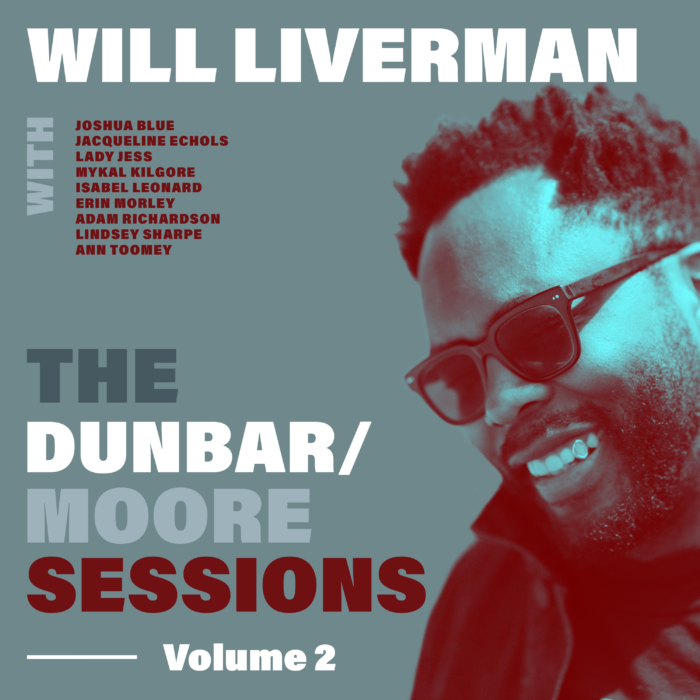
ABAO 2022-23 Review: I Puritani
Jessica Pratt Shines in Emilio Sagi’s Impressive Production
By Mauricio VillaThe ABAO 2022-23 season opened with an offering of the critical edition of Bellini’s “I Puritani” by Fabrizio della Seta. It featured Bel Canto expert Jessica Pratt and promising tenors Xavier Anduaga in the award-winning production by Emilio Sagi.
Sagi’s “Puritani” has been already appeared in several theatres around the world, its last revival was at the Opera de Oviedo in 2020 where the sets had to be adapted to the small stage of Teatro Campoamor. The vast stage of the Euskalduna recovered the original set which consisted of an ever-changing big black mirror box. The bright black sparkle of the walls makes a big contrast with the white sand that covers the floor of the stage. There is a romantic touch with a painted canvas that presents a forest and a bright full moon for the first scene of Act three. There are chairs in various scenes, which is a trademark in Sagi’s productions, and lots of bright chandeliers which lower, even to floor level, or rise in several positions along with the action. It’s a beautiful oneiric space.
Sagi is also very clever. The libretto of “I puritani,” written by Carlo Pepoli, is one of the most incompressible plots in the history of opera and if the opera was a huge success at its premiere and has continued in the repertoire since then it is due to Bellini’s magnificent score. Sagi does not try to justify the unjustifiable or create fake cliché scenes. Instead, he builds a romantic world where the music is the absolute protagonist of the opera. Nevertheless, there are strong theatrical effects like the shadows of the members of the court running wildly around the stage projected on the fringe curtain, or when Elvira runs along the curtain creating some kind of wave as she touches the fringes. I am not sure if this was the intention, but the set worked like a resonance box and therefore the voices of all the singers sounded bigger than usual and carried over the orchestra easily.
Star Soprano
Jessica Pratt portrayed the role of Elvira. She is an example of a soprano who knows and cares for her instrument and therefore has always sang adequate roles according to her repertoire. She possesses a truly Lirico-ligera voice, as her middle register has widened and darkened. While her vibrato has slowed down in the centre of her voice due increase in vocal heft, she maintains an extremely high range (up to high G) and immaculate coloratura technique.
Elvira is written for a lyrical soprano with coloratura and easy high notes. The fact that Pratt’s voice has added depth in the middle register enables her to sing her first act duet with the bass with vocal presence and authority and still sing fast and effortlessly during the multiple scales that pass through high B naturals.
Pratt sang soaring crystalline crescendos and diminuendos on the several A naturals during ”A te o cara” and the polonaise “Son vergin vezzosa” was her first chance to offer a showcase of staccato high notes, trills and some subtle variations (it is always nice to hear singers singing their own variation, rather than the ones imposed by tradition, as it gives some freshness to the piece) ascending constantly to high Ds.
The interpretation of the aria ”Ah viene al tiempo” was full of sorrow and melancholy. She sang the expansive Bellini melody with long fiato lines and chose the traditional variation of singing the repetition of the verse one an octave higher; this demands the soprano to emit 5 high Cs and a high D in a legato single line. Pratt moved easily and beautifully to the higher register delivering exquisite ringing high notes. The soprano ended the first act with an unexpected long sustained high F.
The third act was written mostly for tenor Rubini and therefore the soprano is delegated only to a long duet and ensemble lines. However, Pratt kept her voice fresh and bright, singing an astonishing pianissimo B flat on the line “un canto d’amor, ah!” and still delivered all the high notes interpolated in the score with brilliant high Cs and Ds. She sang the final cabaletta “Ah! Sento o mio bell’angelo” with joy and brightness; she also delivered original new variations on the repetition and a bright long high D to conclude the opera.
The second act is the big moment for the soprano as she must take on the mad scene “O rendetemi la speme…vien diletto.” Pratt showed voice control and technique and focused on portraying the madness of the heroine, coloring her vocal line and keeping the sound light and in a very high position. This enabled her to sing the cabalett “Vien diletto” where the tessitura rises up drastically; the passage is full of fast scales and coloratura going up to high D flats. As expected, Pratt pulled it all off with bravura. She introduced her own variations on the repetition of the cabaletta and finished the piece with the traditional high E flat.
Jessica Pratt was the absolute protagonist of the evening, displaying immaculate Bel Canto style, depurated clean coloratura, sparkling high notes, and deep characterization of the role.
Promising But Disappointing
The young Spanish tenor Xavier Anduaga is one of most exciting tenors singing today. He has gained great international attention after winning Operalia contest in 2019, and has already sung leading roles at the major European opera houses. He has a Lirico-leggero voice with a beautiful warm timbre, mesmerizing projection, and extreme high notes all the way up to high F.
His interpretation of his entrance aria:”A te o cara” was immaculate with long legato lines in one breath, splendid dynamics with soaring pianissimi and mezza voce, and a long sustained high C sharp.He sang the line “in pianto” with exquisite mezza voce although notes around the passagio (F and G) were a bit flat. He seems so focused on voice production and projection that his diction is sometimes completely lost. One such example was on the line ”tra la gioja le l’esultar,” but this was a constant throughout his performance. He dealt easily with the uncomfortable tessitura of ”Non parlar di le che adoro” and was heroic and aggressive during “Sprezzo audace,” delivering a secure high B natural and clean coloratura. He returned to lyricism and dynamics in the rarely performed trio “Se il destin a te m’invola” where the tessitura becomes higher; however, Anduaga’s phrasing, while navigating that extreme tessitura, featured blurred diction.
But things got a bit tricky during the third act. Arturo opens the act with a 15-minute scene with a long aria which is interrupted twice – by Elvira and by the chorus. A whole verse was cut leaving the scene at just seven minutes; considering that up until that point there had been no major cuts, I began wondering if it was the conductor or the tenor’s choice.
He sang the scene “Son salvo…A una fonte” with expansive legato lines but he abruptly reduced his use of mezza voce and diminuendos. During the duet with Elvira, he moved past the high B natural quickly. At that point, it was easy to tell that something was not right. The B natural is written as a quaver but it has a pause, which means that the singer is free to hold the note as long as he wants.
During “ Da quel di…” another exposed B natural was cut. What’s the point in performing extra music if some lines are going to be cut? Then “Viene fra queste braccia” arrived. This is one of the most feared sections for tenors as they have to sing two long high Ds completely exposed. Once more the duet was heavily cut leaving the piece at about two minutes, when it usually lasts five minutes. Andagua’s first high D was very short as he could barely hold the note. The attack was clean but the D is written as a dotted half-note, but the tenor didn’t manage the full length. He was lucky Pratt was singing the second high D with him as he had problems attacking the note and nearly cracked; again, he cut the length of the note down. At the end of the passage the two switched lines, giving Pratt the high line and Andagua the low line; the problem is that it is written the opposite way.
His final “Credeasi missera,” which features a lower tessitura, was solid, but his two high D flats were unpolished with the second high note sounding pushed and tense. He also omitted the high F written in the repeat, something that most tenors try to sing nowadays.
The score of the critical edition includes a new ending “Ah! Sento o mio bell’angelo” for Arturo and Elvira, where the tenor is supposed to sing the high line. But Andagua remained silent, leaving the piece as a solo for soprano, something Joan Sutherland used to do.
Ultimately, is it fair to judge one performance based on the high notes that the singer sings? No. But in a opera like “Puritani,” written for a very high tenor with a high tessitura and extreme high notes, the fact that some lines are cut to avoid high notes and that the high notes that are sang turned out to be extremely short and pushed, indicates that this role might not be ideal for this singer.
Andagua is just 27-years-old, and I consider that “I puritani” demands a vocal maturity and secure high notes that this particular tenor lacks. That said, his timbre is beautiful, his voice projected well, he pulled off amazing pianissimi and soaring mezza voce. The third act was just too heavy for him.
Questionable Style
Andrezj Filonczyk sang the role of Sir Arturo Talbo. He possesses a lyrical instrument with a beautiful timbre and a marked vibrato. His voice has modest volume but carried easily over the orchestra. He sang with fluid legato lines during his opening aria “Ah! Per sempre io ti perdei,” although he sacrificed diction which was blurred in order to keep the fluidity of the line. His emphasis on the attack of some notes turned out to be abrupt, breaking with the bel-canto style. He sang the traditional interpolated high G on the cadenza of the aria, and during the repetition of the cabaletta “Bel sogno beato,” he added 12 extra bars belonging to the critical edition. The tempi for the coloratura section of the end of the cabaletta was heavily reduced, so the baritone could sing the scales comfortably, unfortunately exposing insecure coloratura technique. He concluded his first intervention with a strong long sustained high G.
He was aggressive and strong during ”Ferma in van,” delivering a strong high F sharp in the cadenza, but once more the coloratura was not clean, the attack of some notes was completely out of the Bel-canto style for its roughness, and his diction was blurred. His singing became heroic and bombastic for the famous duet “Suoni la trompa” and his voice blended nicely with that of bass Manuel Fuentes. It was disappointing that he didn’t sing the final interpolated high A flat; he tried to reach the note but stop singing immediately, leaving the bass alone for the final bars.
Manuel Fuentes portrayed the role of Sir Giorgio. He has a dark powerful voice, with an even round sound from low to high. He controls his big voice and that enables him to sing long legato lines (which is the basis of Bellini’s writing) and therefore the interpretation of his aria “Cinta di Fiori” was fluid, sorrowful and deeply emotional. The rest of his appearances were in duets or ensembles, where his voice was always present.
The interpretation of the short roles of Enrichetta and Bruno by Laura Vila and Josu Cabrero were solid in style and commitment to acting.
Italian conductor Giacomo Sagripanti opened the overture by playing the Allegro Assai in an uncommonly fast tempo with a strong heroic imprint. He made a big contrast during the subsequent Allegro sostenuto section by pacing the tempi while maintaining momentum. Nevertheless, Sagripanti knew how to make the “moon Bellini melodies” (as they has been named) fluid, long and ethereal, so moments like “A te o cara” or “Qui la voce” were played in the usual stretched legato soaring tempi that this music requires. And this was the basis of his work: big contrasts between strong, bombastic and heroic tempi with slow tempi that favored the melancholy of Bellini’s long melodies. He offered a critical edition with barely any cuts (except for the aforementioned ones in Act three), which included sections of music which are rarely performed like the trio ”Se il destin a te m’invola” in Act one and “Da quell di ch’io ti mirai,” and “Ah! Sento o mio bell’angelo” in Act three.
The Euskadiko Orkestra and Coro de la Opera de Bilbao responded well to Sagripanti, delivering strong heroic, and melancholic moments.
While this was a good attempt to present the critical edition of Bellini’s final masterpiece, this was a major disappointment due to the severe cuts in the third act. But that didn’t take away from the romantic and evocative production starring an absolute star like Pratt.


